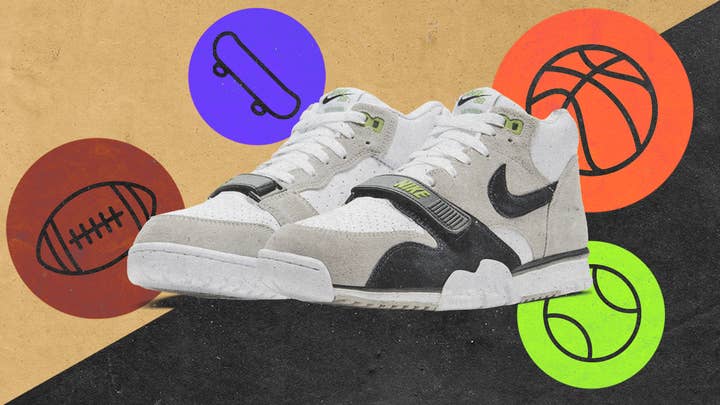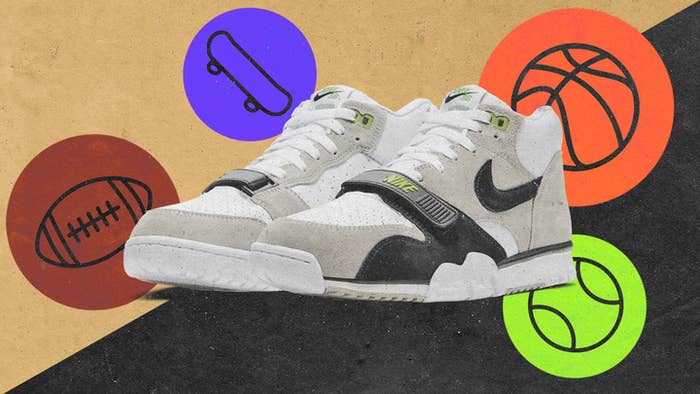
Chances are the “Chlorophyll” Nike SB Air Trainer 1 won’t land on any year-end recaps of best releases. Understandable, considering the decades-old model doesn’t align with today’s footwear tastes. But in terms of historical relevance, few sneakers better capture Nike’s early DNA as industry leaders, problem-solvers, and purveyors of cool.
The Nike Air Trainer 1 was born out of equal parts necessity and imagination. Prior to the shoe’s release in 1987, no multipurpose sneaker existed to satisfy the needs of Tinker Hatfield. The Nike designer grew tired of carrying a bag filled with multiple shoes to the gym for workouts where he would run, shoot hoops, lift weights, and play racquetball. Figuring other gym-goers shared his frustration, Hatfield decided to solve the problem by designing a model capable of whatever physical activities users desired.
The concept irked a few of his co-workers, as Hatfield's ideas sometimes did back then. The marketing department dubbed it a "pretty stupid project," one they thought would take sales from the basketball and running categories. Hatfield knew they just couldn't see the vision. "The shoe was going to be a compromise," he recalled in a 2009 Sole Collector interview. "We can always design a better basketball shoe or a better running shoe, but this is going to sit in the middle where it's good enough for most people."
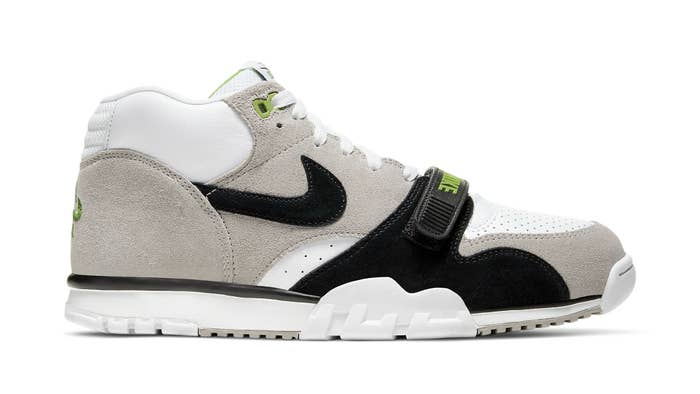
Sensing he was onto a good idea, Hatfield forged ahead with the backing of friend and collaborator Mark Parker, who oversaw research and development at the time and rose to CEO decades later.
The end product was 1987’s Air Trainer Hi, as it was originally known. The model stood with a little more heel lift than a basketball shoe, but less lift than a running shoe. The lateral outrigger added support and stability. One of its hallmark features, a strap, adorned the forefoot and created an adjustable, lockdown feel. The mix of materials—leather and nubuck—was dressed in shades of gray, white, and black, accented by traces of Chlorophyll Green, which became its signature colorway. It launched alongside the visible Nike Air and the Air Max 1 and Revolution campaign in what would become a pivotal time in the brand's history.
The Air Trainer 1 received a warm welcome from the start. Athletes, both professional and weekend warriors, took to the shoe immediately for its jack-of-all-trades attributes. Hatfield's decision to chase a wild idea didn't just spawn a single shoe; it birthed a whole new category. Throughout the ’90s, Cross Trainers occupied prime retail space beside signature basketball shoes and the latest Air Max models.
The "Bo Knows" ad campaigns featuring Bo Jackson caused many to associate the Trainer 1 with the two-sport phenom who played outfielder for baseball's Kansas City Royals and running back for the then-Oakland Raiders. And, rightfully so. However, tennis bad boys John McEnroe and Andre Agassi gave the Trainer 1 its true attitude. A mischievous McEnroe debuted a prototype version of the model in 1986 without permission, which perfectly fits the shoe's rebellious narrative. "The fact that you can have a Swiss Army Knife of a performance shoe absolutely blew my mind," notes Andrew Incogs, a longtime Nike and tennis devotee who goes by the handle @sneakerpreservationsociety on Instagram. "I mean, Mac basically strong-armed the shoe into becoming secondarily synonymous with tennis."
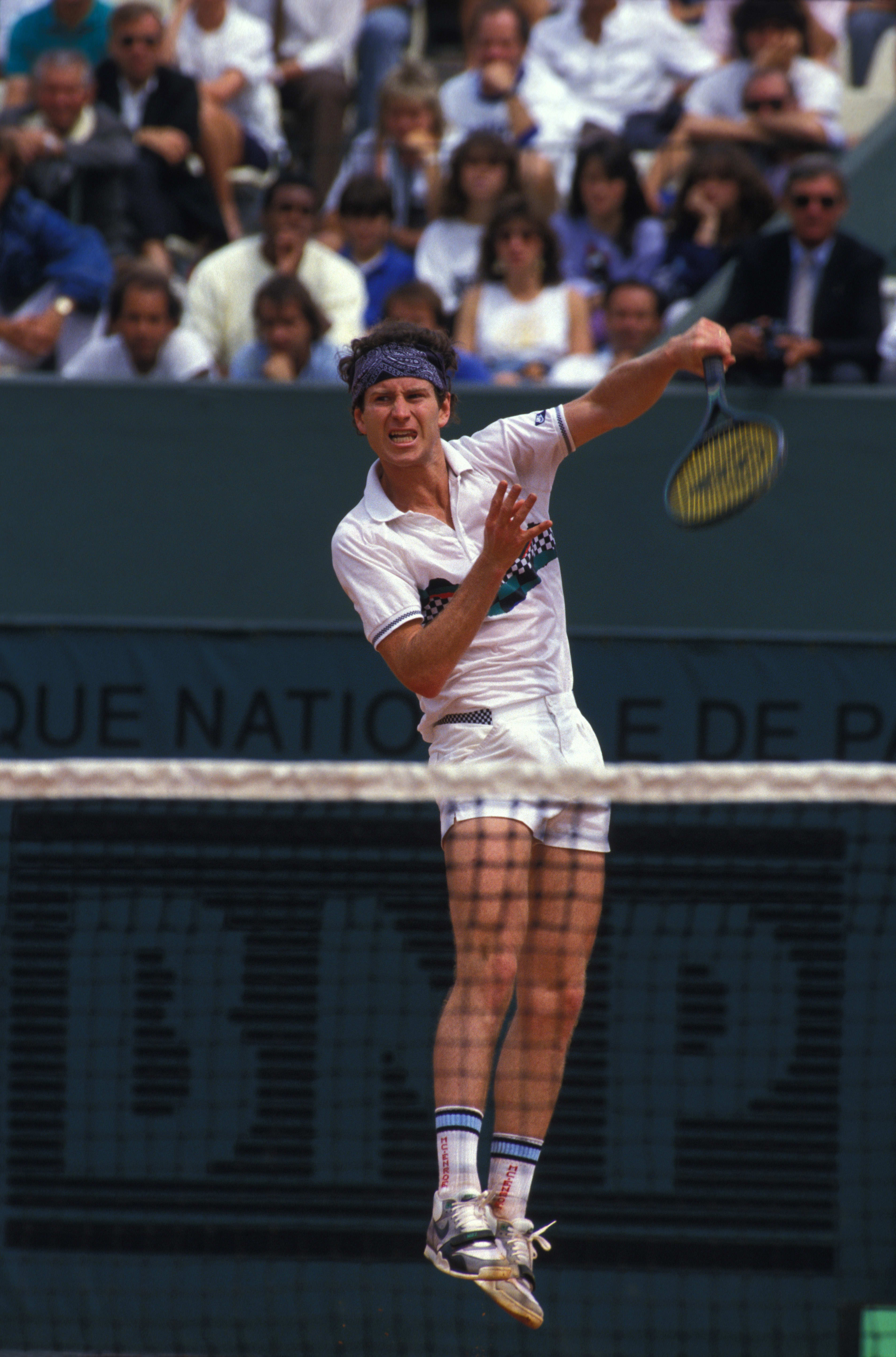
The Trainer 1 received a modest amount of attention since its initial launch. With the cross-training concept being replaced by sports such as CrossFit, the sneaker doesn't get as much love. Nike only releases a sparse number of colorways every few years. Truthfully, the multiple layers of material and stitching make the design inefficient by current standards. Still, Nike rolls out a few fresh color-ups on a sporadic basis that keep the silhouette. Those retros and the growth of the online sneaker community kept the Trainer 1's legacy alive in a sneaker world where collaborations and hype began to drive trends.
NikeTalk fostered my love affair with the model in the early 2000s. Even though I lived during its original heyday, basketball sneakers ate up the annual shoe budget my parents provided as a kid. The internet presented a chance to learn about any model in depth. I buried myself in the Trainer category instead of commonplace choices like Jordans and Air Maxes. Those were cool, but Trainers meant less competition for pairs. Plus, the niche nature made them more appealing than what the masses were chasing after.
Wearing shoes like the Trainer 1s indicates a deeper appreciation for old Nike models. They elicit an approving nod from fellow footwear fans. Wallyhopp, the NikeTalk member known for his wealth of knowledge on the Trainer category, knew this experience firsthand.
"I was too young for the first initial launch, but I remember in college around 2003-2006 when the Nike Cross Trainer genre had a rebirth series come out," he writes via email. "I remember wearing the lineup around campus and watching older heads stir up conversations with me. At the time, these older guys were noticing the Trainers. They truly hadn't released or been seen for 16 years. That says a lot about staying power."
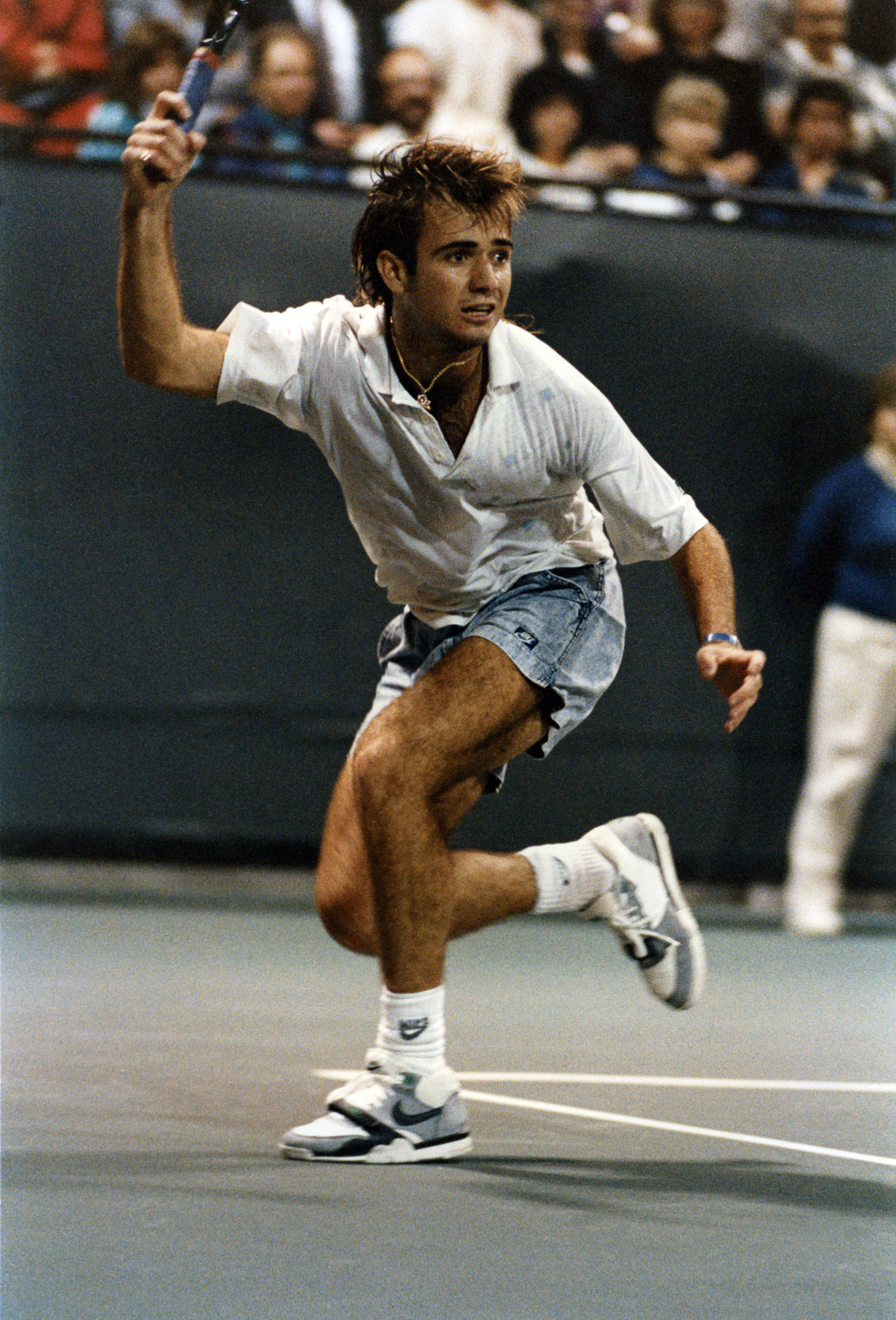
Along the way, an odd synergy occurred when the skateboarding community adopted the model. Skaters always appreciated Nike basketball sneakers, especially the Air Jordan 1 when it first released, and later the Dunk. Nike's marketing helped, as did familiarity bred by Savier, the now-defunct predecessor to Nike SB, and a model simply named the Trainer, which was essentially the Trainer 1 silhouette sans Swoosh. Whatever the case, it formed another community outside of the traditional sneaker subsets who appreciated what the shoe has to offer.
In fact, a few of the best-known Trainer 1 color-ups hail from Nike SB. Alongside the initial onslaught of Dunks released under the SB umbrella, the "Paul Brown" Nike SB Trainer 1 which dropped in an odd mix of brown, black, and navy blue from 2003, stands as one of the strongest versions. Unusual color schemes with even quirkier nicknames—Huf's "Gold Digger" collab (2005), "Bamboo" (2006), "Dawn of the Dead" (2007)—marked SB releases over the years.
Nike SB didn't revisit the silhouette again until 2019's collab with Polar Skate Co. The black, blue, and white colorway sported a durable suede forefoot support piecema, thick but pliable leather, gum-colored outsoles, and Polar branding. A damn good combination that exhibited the attention to detail the model deserved.
It set the stage for 2020's remake of the original "Chlorophyll Green" colorway, last retroed in 2012, to be released under the Nike SB umbrella. The revamped version featured all new materials: a mesh tongue, more suede than leather, and SB branding. It was like a scavenger hunt, since they were technically an in-store only release limited to Orange Label accounts, the brand’s designation for its core skate shops. The strategy created a mad scramble filled with calls and emails between friends worldwide trying to secure a pair through 70 or so shops scattered across the globe.
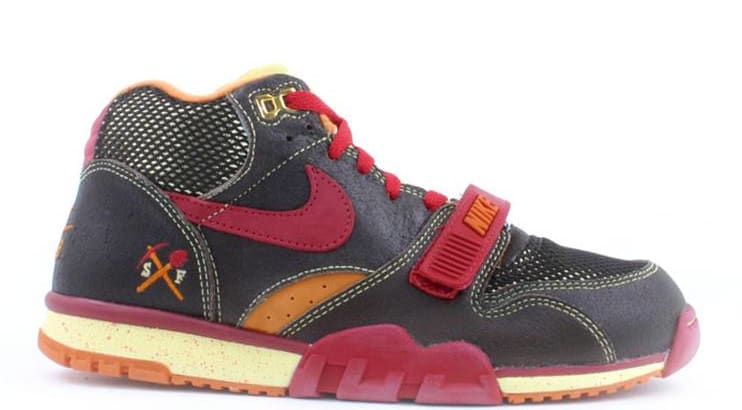
A friend living in Wilmington, Delaware, picked up a pair on my behalf through Kinetic Skateshop. Even with the shoe's niche appeal, store co-owner Ben Jones says the "Chlorophyll" Trainer was well received.
"This one definitely wasn't as crazy as the Dunk releases have been, but there definitely is love for the Air Trainer in the sneaker and skate communities," he says. "It was mostly skaters and sneaker collectors we know and have been seeing for years."
Jones noted skaters 20 and older were excited because they remembered Huf's "Gold Digger" collab from 2005. The recent Polar release stoked the fires as well.
"There is a lot of love for Huf in that age cohort, and it's nice to look back on that after Keith Hufnagel's untimely passing," he says. "With everyone else, there was some awareness of the Trainer from the Oski/Polar release from last year. Everyone loves Oski, and Polar is one of our best-selling board brands, so that one did well and made sure there was some awareness."
Thirty years later, the Trainer, with its multiple layers, stands as no match to modern one-piece knitted constructions. Still, older heads know the role the model plays in Nike's history.
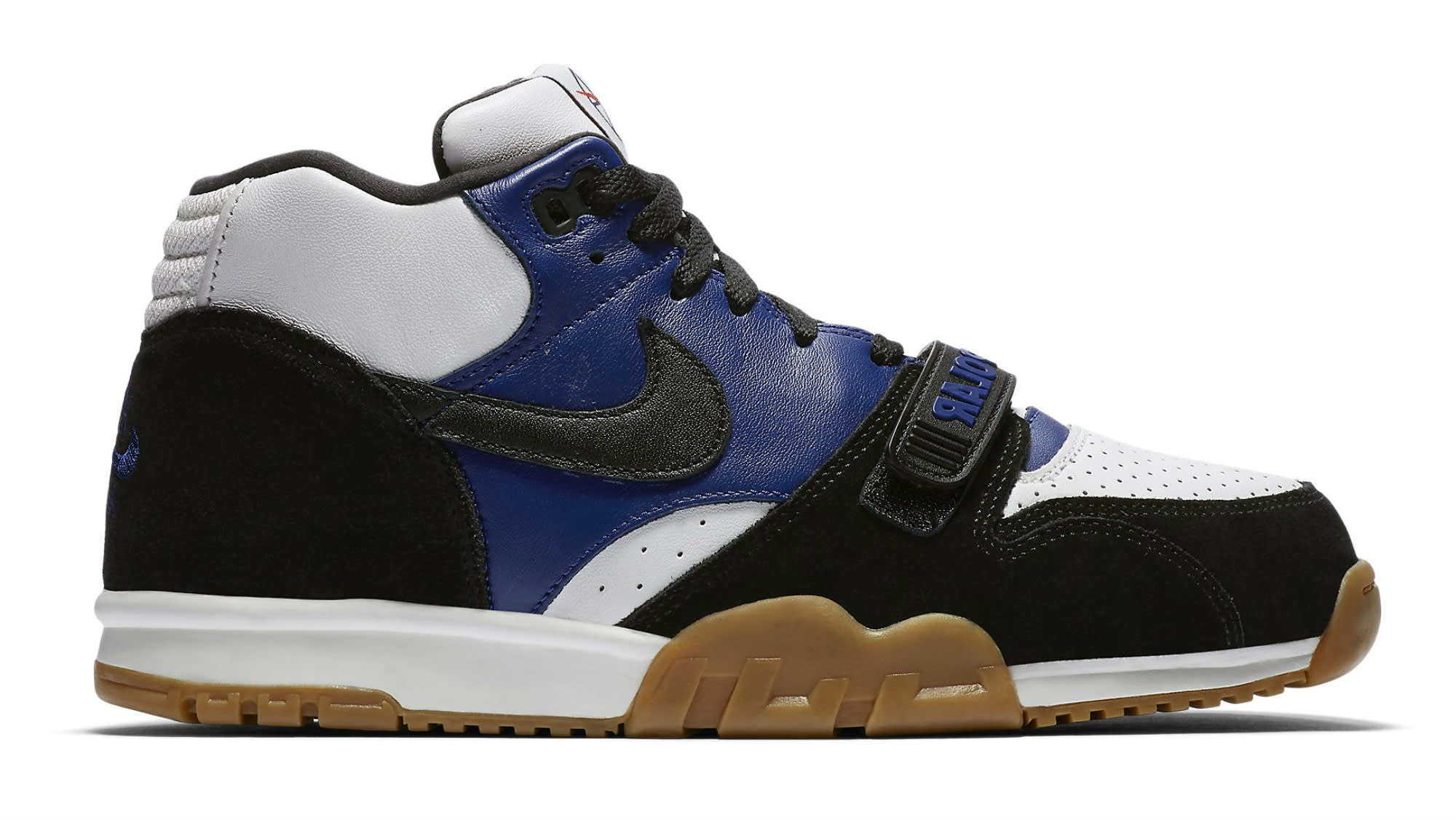
"Ultimately, the Air Trainer design language set the stage for most of what Nike did from 1988-1994, crossing over into basketball and inspiring things like the Jordan 3," old school sneaker aficionado Adam Leaventon, known as AirRev on Instagram, once wrote for a list where he crowned the Air Trainer as the top tennis shoe ever made. To this day, he still stands by the statement but takes the recognition a step further.
"I think there are many people who consider it to be the greatest sneaker of all time," he says via email. "But that's mostly among the real knuckleheads."
The sentiment is one shared by Incogs.
"I like to believe there is a small segment of patrons who love and appreciate the AT1 above and beyond whatever 'flavor of the week' model drops on Saturday at 7 a.m. Pacific," he says. "Nike will play to that nostalgia on occasion. However, the real reason, from a business/marketing perspective, is Tinker. He is that God-level designer. It's easy to build hype around his creations, the AT1 being, in my own eye, the pinnacle of design and innovation.

